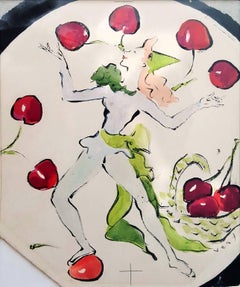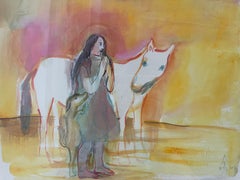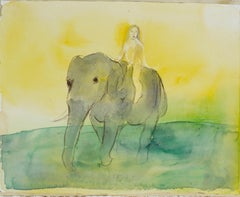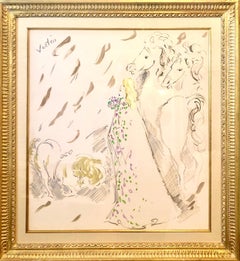Marcel Vertès Paintings
to
2
2
2
Overall Height
to
Overall Width
to
1
1
2
2
2
2
2
2
2
42
919
650
639
610
2
2
2
Artist: Marcel Vertès
Cherry Dancer
By Marcel Vertès
Located in Miami, FL
Cherry Dancer
Marcel Vertes
French, 1895-1961
Beautiful girl juggling cherries
Work is round but is shown in a square frame and some of the artworks edge is exposed
Description: ...
Category
1930s Post-Impressionist Marcel Vertès Paintings
Materials
Gouache
Art Deco Cherry Dancer
By Marcel Vertès
Located in Miami, FL
Cherry Dancer
Marcel Vertes
French, 1895-1961
Beautiful girl juggling cherries is a beautiful and charming idea that is deftly rendered in a quick and loose style.
Work is round
De...
Category
1930s Art Deco Marcel Vertès Paintings
Materials
Gouache
Related Items
Expressionist Figurative water color painting- Series The Horse Whisper No.2-25
Located in Beijing, CN
Expressionist Figurative water color painting by Zhang Chunyang
Series The Horse Whisper No.2-25
Dimension: 29 x 36 cm
Material: Gouache, Watercolor on Paper
Date: 2013
Artist B...
Category
2010s Expressionist Marcel Vertès Paintings
Materials
Watercolor, Gouache, Handmade Paper
Zhang ChunyangExpressionist Figurative water color painting- Series The Horse Whisper No.2-25 , 2013
Free Shipping
H 11.42 in W 14.18 in
Expressionist Figurative water color painting- Luckiness
Located in Beijing, CN
Expressionist Figurative water color painting by Zhang Chunyang
Title: Luckiness
Dimension: 29 x 36 cm
Material: Gouache, Watercolor on Paper
D...
Category
2010s Expressionist Marcel Vertès Paintings
Materials
Watercolor, Gouache, Handmade Paper
Free Shipping
H 11.42 in W 14.18 in
The Abduction of the Sabine Women , a Renaissance drawing by Biagio Pupini
Located in PARIS, FR
This vigorous drawing has long been attributed to Polidoro da Caravaggio: The Abduction of the Sabine Women is one of the scenes that Polidoro depicted between 1525 and 1527 on the façade of the Milesi Palazzo in Rome. However, the proximity to another drawing inspired by this same façade, kept at the Ecole des Beaux-Arts, and to other drawings inspired by Polidoro kept at the Musée du Louvre, leads us to propose an attribution to Biagio Pupini, a Bolognese artist whose life remains barely known, despite the abundant number of drawings attributed to him.
1. Biagio Pupini, a Bolognese artist in the light of the Roman Renaissance
The early life of Biagio Pupini, an important figure of the first half of the Cinquecento in Bologna - Vasari mentions him several times - is still poorly known. Neither his date of birth (probably around 1490-1495) nor his training are known. He is said to have been a pupil of Francesco Francia (1450 - 1517) and his name appears for the first time in 1511 in a contract with the painter Bagnacavallo (c. 1484 - 1542) for the frescoes of a church in Faenza. He then collaborated with Girolamo da Carpi, at San Michele in Bosco and at the villa of Belriguardo.
He must have gone to Rome for the first time with Bagnacavallo between 1511 and 1519. There he discovered the art of Raphael, with whom he might have worked, and that of Polidoro da Caravaggio. This first visit, and those that followed, were the occasion for an intense study of ancient and modern art, as illustrated by his abundant graphic production.
Polidoro da Caravaggio had a particular influence on the technique adopted by Pupini. Executed on coloured paper, his drawings generally combine pen, brown ink and wash with abundant highlights of white gouache, as in the drawing presented here.
2. The Abduction of the Sabine Women
Our drawing is an adaptation of a fresco painted between 1525 and 1527 by Polidoro da Caravaggio on the façade of the Milesi Palace in Rome. These painted façades were very famous from the moment they were painted and inspired many artists during their stay in Rome. These frescoes are now very deteriorated and difficult to see, as the palace is in a rather narrow street.
The episode of the abduction of the Sabine women (which appears in the centre of the photo above) is a historical theme that goes back to the origins of Rome and is recounted both by Titus Livius (Ab Urbe condita I,13), by Ovid (Fasti III, 199-228) and by Plutarch (II, Romulus 14-19). After killing his twin brother Romus, Romulus populates the city of Rome by opening it up to refugees and brigands and finds himself with an excess of men. Because of their reputation, none of the inhabitants of the neighbouring cities want to give them their daughters in marriage. The Romans then decide to invite their Sabine neighbours to a great feast during which they slaughter the Sabines and kidnap their daughters.
The engraving made by Giovanni Battista Gallestruzzi (1618 - 1677) around 1656-1658 gives us a good understanding of the Polidoro fresco, allowing us to see how Biagio Pupini reworked the scene to extract this dynamic group.
With a remarkable economy of means, Biagio Pupini takes over the left-hand side of the fresco and depicts in a very dense space two main groups, each consisting of a Roman and a Sabine, completed by a group of three soldiers in the background (which seems to differ quite significantly from Polidoro's composition).
The balance of the drawing is based on a very strongly structured composition. The drawing is organised around a median vertical axis, which runs along both the elbow of the kidnapped Sabine on the left and the foot of her captor, and the two main diagonals, reinforced by four secondary diagonals. This diamond-shaped structure creates an extremely dynamic space, in which centripetal movements (the legs of the Sabine on the right, the arm of the soldier on the back at the top right) and centrifugal movements (the arm of the kidnapper on the left and the legs of the Sabine he is carrying away, the arm of the Sabine on the right) oppose each other, giving the drawing the appearance of a whirlpool around a central point of support situated slightly to the left of the navel of the kidnapper on the right.
3. Polidoro da Caravaggio, and the decorations of Roman palaces
Polidoro da Caravaggio was a paradoxical artist who entered Raphael's (1483 - 1520) workshop at a very young age, when he oversaw the Lodges in the Vatican. Most of his Roman work, which was the peak of his career, has disappeared, as he specialised in facade painting, and yet these paintings, which are eminently visible in urban spaces, have influenced generations of artists who copied them abundantly during their visits to Rome.
Polidoro Caldara was born in Caravaggio around 1495-1500 (the birthplace of Michelangelo Merisi, known as Caravaggio, who was born there in 1571), some forty kilometres east of Milan. According to Vasari, he arrived as a mason on the Vatican's construction site and joined Raphael's workshop around 1517 (at the age of eighteen according to Vasari). This integration would have allowed Polidoro to work not only on the frescoes of the Lodges, but also on some of the frescoes of the Chambers, as well as on the flat of Cardinal Bibiena in the Vatican.
After Raphael's death in 1520, Polidoro worked first with Perin del Vaga before joining forces with Maturino of Florence (1490 - 1528), whom he had also known in Raphael's workshop. Together they specialised in the painting of palace façades. They were to produce some forty façades decorated with grisaille paintings imitating antique bas-reliefs.
The Sack of Rome in 1527, during which his friend Maturino was killed, led Polidoro to flee first to Naples (where he had already stayed in 1523), then to Messina. It was while he was preparing his return to the peninsula that he was murdered by one of his assistants, Tonno Calabrese, in 1543.
In his Vite, Vasari celebrated Polidoro as the greatest façade decorator of his time, noting that "there is no flat, palace, garden or villa in Rome that does not contain a work by Polidoro". Polidoro's facade decorations, most of which have disappeared as they were displayed in the open air, constitute the most important lost chapter of Roman art of the Cinquecento. The few surviving drawings of the painter can, however, give an idea of the original appearance of his murals and show that he was an artist of remarkable and highly original genius.
4. The façade of the Milesi Palace
Giovanni Antonio Milesi, who commissioned this palace, located not far from the Tiber, north of Piazza Navona, was a native of the Bergamo area, like Polidoro, with whom he maintained close friendly ties. Executed in the last years before the Sack of Rome, around 1526-1527, the decoration of Palazzo Milesi is considered Polidoro's greatest decorative success.
An engraving by Ernesto Maccari made at the end of the nineteenth century allows us to understand the general balance of this façade, which was still well preserved at the time. The frescoes were not entirely monochrome, but alternated elements in chiaroscuro simulating marble bas-reliefs and those in ochre simulating bronze and gold vases...
Category
16th Century Old Masters Marcel Vertès Paintings
Materials
Ink, Gouache, Pen
Freya (Seated Backwards), Mixed media on grey board
By Howard Tangye
Located in London, GB
Howard Tangye (b.1948, Australia) has been an influential force in fashion for decades. Lecturing at London’s Central Saint Martins for 35 years, including 16 years as head of BA Wom...
Category
2010s Contemporary Marcel Vertès Paintings
Materials
Other Medium, Archival Paper, Handmade Paper, Pen, Felt Pen, Permanent M...
French School (18th Century) Dancing Putti.
Located in Sydney, NSW
French School (18th Century), Dancing Putti.
This gouache on vellum scene of the dancing putti is derived from a drawing by Giovanni Antonio de' Sacchis (Italian 1484 -1539) known a...
Category
Late 18th Century Rococo Marcel Vertès Paintings
Materials
Gouache, Vellum
MADELEINE (ORIGINAL GOUCHE)
By Erté
Located in Aventura, FL
Unique, one of a kind original gouache on paper from Harper's Bazar series. Hand signed lower front by Erte; titled top front with studio catalog number on verso. Sheet size 10.7...
Category
1950s Art Deco Marcel Vertès Paintings
Materials
Gouache
Mayan, Large 20th Century Watercolor, Viktor Schreckengost
By Viktor Schreckengost
Located in Beachwood, OH
Viktor Schreckengost (American, 1906-2008)
Mayan
Watercolor heightened with gouache over pencil on paper
Signed lower right
39 x 29 inches
45.5 x 35.5 inches, framed
Registered with The Viktor Schreckengost foundation, stock no. 6891
The son of a commercial potter in Sebring, Ohio, Viktor Schreckengost learned the craft of sculpting in clay from his father. In the mid-1920s, he enrolled at the Cleveland School of Art (now the Cleveland Institute of Art, or CIA) to study cartoon making, but after seeing an exhibition at the Cleveland Museum of Art he changed his focus to ceramics. Upon graduation in 1929, he studied ceramics in Vienna, Austria, where he began to build a reputation, not only for his art, but also as a jazz saxophonist. A year later, at the age of 25, he became the youngest faculty member at the CIA. In 1931, Schreckengost won the first of several awards for excellence in ceramics at the Cleveland Museum of Art, and his works were shown at the Metropolitan Museum of Art, the Art Institute of Chicago, the Panama-Pacific Exposition in San Francisco, and elsewhere.
By the mid-1930s, Schreckengost had begun to pursue his interest in industrial design. For American Limoges...
Category
20th Century Art Deco Marcel Vertès Paintings
Materials
Watercolor, Gouache
"We, " Oil Paint on Plywood, 2014
Located in Chicago, IL
Entitled "We," this exquisite woodcut by Chinese artist Ren Hui celebrates joy and the beauty of humanity with a crowd of smiling faces. Using a style he calls “uncomplicated and hon...
Category
21st Century and Contemporary Pointillist Marcel Vertès Paintings
Materials
Oil, Plywood
Jake W. (Before Paris II), Mixed media on Fabriano paper
By Howard Tangye
Located in London, GB
Howard Tangye (b.1948, Australia) has been an influential force in fashion for decades. Lecturing at London’s Central Saint Martins for 35 years, includi...
Category
2010s Contemporary Marcel Vertès Paintings
Materials
Felt Pen, Pencil, Carbon Pencil, Color Pencil, Graphite, Gesso, Pigment,...
Oleg (Kimono), Mixed media on ochre parchment paper
By Howard Tangye
Located in London, GB
Howard Tangye (b.1948, Australia) has been an influential force in fashion for decades. Lecturing at London’s Central Saint Martins for 35 years, including 16 years as head of BA Wom...
Category
2010s Contemporary Marcel Vertès Paintings
Materials
Paint, Paper, Parchment Paper, Charcoal, Crayon, Oil Crayon, Oil Pastel,...
Natasha (Sitting), Mixed media on Pergamenata parchment
By Howard Tangye
Located in London, GB
Howard Tangye (b.1948, Australia) has been an influential force in fashion for decades. Lecturing at London’s Central Saint Martins for 35 years, including 16 years as head of BA Womenswear. There, he tutored many contemporary greats, including John Galliano, Stella McCartney, Christopher Kane, Wes Gordon, Zac Posen and Hussein Chalayan.
Examples of Tangye’s portraits are held in many important collections, both public and private, including the Victoria and Albert Museum (V&A), Harvard University and London’s National Portrait Gallery.
Throughout his teaching career Tangye quietly developed a particularly idiosyncratic art practice. By employing a decisive line with bold applications of richly layered materials, Tangye explores the nuances of the human form in an effort to expose his subjects’ true essence and energy.
—
Howard Tangye
Natasha (Sitting), 2012
Mixed media on Pergamenata parchment
100 x 70 cm (39.37 x 27.55 in)
(signed) (unframed)
—
This portrait shows Natasha, an ex-student and model. Here she’s posed in Howard’s studio wearing a look from Louise Gray’s S/S 2013 collection. The collection featured headwear by Stephen Jones, the renowned British milliner who created the cut-out plexiglass fascinator Natasha wears here.
This work hails from a series commissioned by Dan Thawley, director of “A Magazine Curated By” for the edition guest edition by Jones who dedicated his issue to Anna Piaggi...
Category
2010s Contemporary Marcel Vertès Paintings
Materials
Gesso, Paint, Paper, Parchment Paper, Chalk, Charcoal, Crayon, Oil Crayo...
Tom Cawson (Sitting - Hand on Head), Mixed media on grey cardboard
By Howard Tangye
Located in London, GB
Howard Tangye (b.1948, Australia) has been an influential force in fashion for decades. Lecturing at London’s Central Saint Martins for 35 years, including 16 years as head of BA Wom...
Category
21st Century and Contemporary Contemporary Marcel Vertès Paintings
Materials
Other Medium, Paint, Graphite, Color Pencil, Carbon Pencil, Pencil, Pen,...
Previously Available Items
Large Art Deco Circus Illustration Gouache Painting Ballerina with Horse and Dog
By Marcel Vertès
Located in Surfside, FL
This is an original gouache painting on board. It appears to be a circus performer or acrobat with horses.
Measures 34 X 24 with mat. 29 X 19 sight
Provenance: Palm Beach estate
M...
Category
Mid-20th Century Post-Impressionist Marcel Vertès Paintings
Materials
Board, Gouache
Original Art Deco Circus Illustration Gouache Painting, Drawing Lady with Horses
By Marcel Vertès
Located in Surfside, FL
This is an original illustration watercolor or gouache painting and drawing on paper. It appears to be a circus performer or acrobat with horses. Measures 26" H x 23-1/2" W, sight. f...
Category
Mid-20th Century Post-Impressionist Marcel Vertès Paintings
Materials
Watercolor, Gouache
Art Deco Original Painting Marcel Vertes Fashion Illustration Design 1940 Framed
By Marcel Vertès
Located in Buffalo, NY
An important original watercolor by Hungarian artist Marcel Vertes depicting a woman in period clothes including a charming ornate floral hat.
This incredible painting is in excellent condition and would come with a COA and appraisal.
Marcel Vertes
An Academy Award winning costume designer for Moulin Rouge, easel and mural painter, illustrator and scenic artist, Marcel Vertes was born in Hungary. His most active years professionally were 1933 to 1952, and he lived in both New York City and Paris, France. In Paris, he was a student at the Academy Julian.
In New York, he was lauded for the original murals at the Cafe Carlyle...
Category
1940s Art Deco Marcel Vertès Paintings
Materials
Paper, Watercolor
Original Art Deco Theatre Costume Illustration Katinka Gouache Painting, Drawing
By Marcel Vertès
Located in Surfside, FL
This is an original Theater costume illustration painting and drawing on paper. Russian bearded Cossack man. stamped Atelier Vertes and pencil si...
Category
1930s Post-Impressionist Marcel Vertès Paintings
Materials
Watercolor, Gouache, Pencil
Original Deco Theatre Costume Illustration "Katinka" Gouache Painting, Drawing
By Marcel Vertès
Located in Surfside, FL
This is an original Theater costume illustration painting and drawing on paper. Russian bearded Cossack man. stamped Atelier Vertes and pencil si...
Category
1930s Post-Impressionist Marcel Vertès Paintings
Materials
Watercolor, Gouache, Pencil
Montmarte, Paris
By Marcel Vertès
Located in Wiscasset, ME
Marcel Vertes was born in Hungary and studied at the Academy Julian in Paris. Following his time at the Academy, Vertes lived and worked in the Latin Quarter, following French Impres...
Category
Modern Marcel Vertès Paintings
Materials
Board, Oil
Circus Rider
By Marcel Vertès
Located in Wiscasset, ME
Marcel Vertes was born in Hungary and studied at the Academy Julian in Paris. Following his time at the Academy, Vertes lived and worked in the Latin Quarter, following French Impressionists Toulouse-Lautrec, Boutet and Forain and depicting scenes of Paris street life in the 1920's.
A painter, illustrator and designer, Vertes was a member of the American Art League, was lauded for his murals in the Hotel Carlyle and, in 1952, and won the British Academy Film award for best costume design for Moulin Rouge. An illustration contributor for Vogue and Harper’s Bazaar, fashion icons Jean Patou, Paul Poiret and Coco Chanel are counted amongst Vertes’ contemporaries. Vertes’ work can be found in collections at the Museum of Modern Art in New York and at museums in Luxembourg and Paris.
A professed fan of the circus and cabaret, Vertes’ “Circus Rider...
Category
1930s Modern Marcel Vertès Paintings
Materials
Gouache
Marcel Vertès paintings for sale on 1stDibs.
Find a wide variety of authentic Marcel Vertès paintings available for sale on 1stDibs. You can also browse by medium to find art by Marcel Vertès in gouache, paint, watercolor and more. Much of the original work by this artist or collective was created during the 20th century and is mostly associated with the Post-Impressionist style. Not every interior allows for large Marcel Vertès paintings, so small editions measuring 8 inches across are available. Customers who are interested in this artist might also find the work of Willy Pogany, Charles Picart le Doux, and Bela Kadar. Marcel Vertès paintings prices can differ depending upon medium, time period and other attributes. On 1stDibs, the price for these items starts at $1,125 and tops out at $3,900, while the average work can sell for $3,900.





